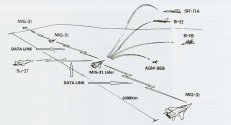The shape that is shown on the images with long thin wings at low sweep angle is not a high-supersonic profile. So while theoretically the plane might be capable of supersonic flight it will not be its default mode of operation because there are no benefits to that.
There were benefits to high speed when missiles and detection were less developed than today. There's no way any aircraft can outrun a dedicated long-range missile, let alone a swarm of them which is linked with a network of sensors. At high supersonic speeds the target creates so much heat and has such a distinct trajectory that it isn't a challenge to write an algorithm that follows it with minimal error. Intelligent IR missiles would quickly put an end to this tactic which is why nobody is really eager to explore it. Low speeds, flares and maneuvering to evade small short-range missiles with small sensors is a viable solution because the capability of the missile is limited. High speeds and no maneuvering to evade a large long-range missile with good sensors is not a viable solution because the capability of the missile has no real upper limit. If you are targeting a strategic bomber then throwing a fighter at it like a Kamikaze is a viable solution.
It’s not entirely true there is no benefit to a large strike or bomber aircraft being capable of significantly supersonic speed.
On an operational level supersonic speed makes aerial interception more difficult by lessening the amount of time interception assets have to get into position to target the intruder, and thus increasing the number of interceptors needed to defend a given frontage.
On tactical level it also reduces the envelop in which an air to air, or surface to air missile can kinematically engage the strike aircraft. So it makes the range of defending missile effectively shorter, thus further complicating the defender’s calculations.
If the strike aircraft deployed supersonic missiles for its strike, say something similar to short range attack missile AGM-69, or any of an array of hypersonic air launched missiles putatively under development, then lunching from a supersonic platform can substantially increase their effective range. This again increases the complexity and difficulty of defending against the attacks launched by supersonic bombers.
The question is always can you afford strike aircraft large enough to have both the necessary range and supersonic performance, and if you can, is that the best use of available resources to improve the combat effectiveness of your entire force. I imagine something that can have heavy bomber range and still be capable of being substantially supersonic will still need to be the size of B-1 or larger.
Several western sources suggest the Chinese did in fact consider building a B-1 style large supersonic heavy strike bomber. Around 2005ish Russia actually offered to lease Tu-22M or Tu-160 to help the Chinese gather experience with this type of aircrsft, in return for participating in the development of such an aircraft. No doubt the Russians hoped such a Chinese bomber might be based on the Tu-160, so the Chinese program would in effect subsidize any future enhancement of Russia’s Tu-160 fleet. But China decided against it and opted to develop a B-2 style bomber with higher emphasis on using stealth for penetration instead.
Last edited:


